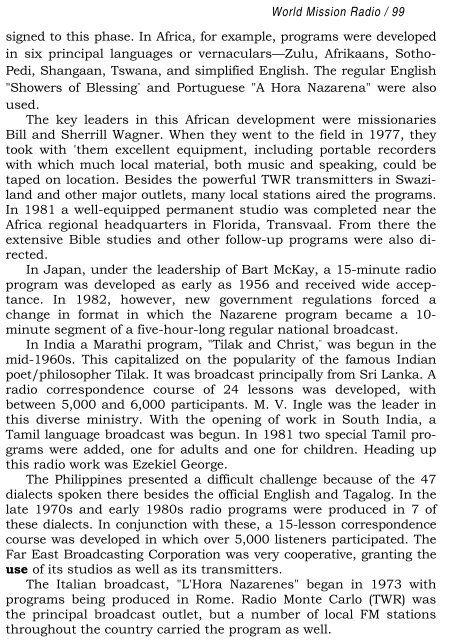The Nazarene World Mission Society
The Nazarene World Mission Society
The Nazarene World Mission Society
You also want an ePaper? Increase the reach of your titles
YUMPU automatically turns print PDFs into web optimized ePapers that Google loves.
<strong>World</strong> <strong>Mission</strong> Radio / 99signed to this phase. In Africa, for example, programs were developedin six principal languages or vernaculars—Zulu, Afrikaans, Sotho-Pedi, Shangaan, Tswana, and simplified English. <strong>The</strong> regular English"Showers of Blessing " and Portuguese "A Hora Nazarena" were alsoused.<strong>The</strong> key leaders in this African development were missionariesBill and Sherrill Wagner. When they went to the field in 1977, theytook with 'them excellent equipment, including portable recorderswith which much local material, both music and speaking, could betaped on location. Besides the powerful TWR transmitters in Swazilandand other major outlets, many local stations aired the programs.In 1981 a well-equipped permanent studio was completed near theAfrica regional headquarters in Florida, Transvaal. From there theextensive Bible studies and other follow-up programs were also directed.In Japan, under the leadership of Bart McKay, a 15-minute radioprogram was developed as early as 1956 and received wide acceptance.In 1982, however, new government regulations forced achange in format in which the <strong>Nazarene</strong> program became a 10-minute segment of a five-hour-long regular national broadcast.In India a Marathi program, "Tilak and Christ, " was begun in themid-1960s. This capitalized on the popularity of the famous Indianpoet/philosopher Tilak. It was broadcast principally from Sri Lanka. Aradio correspondence course of 24 lessons was developed, withbetween 5,000 and 6,000 participants. M. V. Ingle was the leader inthis diverse ministry. With the opening of work in South India, aTamil language broadcast was begun. In 1981 two special Tamil programswere added, one for adults and one for children. Heading upthis radio work was Ezekiel George.<strong>The</strong> Philippines presented a difficult challenge because of the 47dialects spoken there besides the official English and Tagalog. In thelate 1970s and early 1980s radio programs were produced in 7 ofthese dialects. In conjunction with these, a 15-lesson correspondencecourse was developed in which over 5,000 listeners participated. <strong>The</strong>Far East Broadcasting Corporation was very cooperative, granting theuse of its studios as well as its transmitters.<strong>The</strong> Italian broadcast, "L'Hora <strong>Nazarene</strong>s" began in 1973 withprograms being produced in Rome. Radio Monte Carlo (TWR) wasthe principal broadcast outlet, but a number of local FM stationsthroughout the country carried the program as well.
















